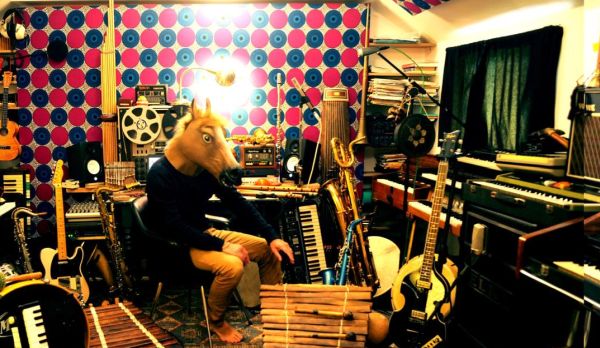

Etienne de la Sayette and the Wild Horses Orchestra
As well as the diversity of his instruments and his skill on them, what sets de la Sayette apart from others is the quality and range of his compositions, which all have memorable, structured tunes, reflecting his wide knowledge of styles. The Wild Horses Orchestra is a fictional ensemble, and this is essentially a completely solo, personal project, much of it done during the pandemic lockdown. But his ability in arranging and playing does create the sound of a band, such that the listener would never guess it’s just one musician. It is augmented on some tracks by drummer Nicolas Brémaud (a fellow member of another of his projects, the Tako Toki trio, whose instruments are made from waste materials), and for one song each by two very different and remarkable singers: Ethiopian Girma Bèyènè and Korean 'changga' diva Kang Kwon Soon. So varied are the styles, and so ingenious the approaches, that I’ll attempt a full rundown of all the tracks. But it really is hard to figure out all of what’s playing; the notes don’t list what instruments are on each track, so I’ll be best-guessing. The harmonium, joined by flutes, leads on “Ali Tango Tango,” and there’s a solo break on what sounds like perhaps an ocarina. “Masqual” has a syncopating, somewhat but not just Balkanish, piano, harmonium flutes and bass lurch, its asymmetry emphasised by a steady cross-rhythm of handclaps.
“Rue Verón” is a perky Parisian-sounding waltz-time, its melody picked out by kalimba and balafon over rolling piano and reedy harmonium. “Nave Nave Moe” has breathy flute in airy, somewhat Indonesian suling style over deep djembe, later joined by a groove of guitar and double bass, with a kalimba solo break.
“Tewdjign Endehu” is characterfully sung by its composer Girma Bèyènè, his short-phrased vocal given a pleasingly plinky accompaniment of kalimba, buzzy balafon and what sounds like chajchas (those hand-shakers usually made from a bunch of goat or sheep toenails), breaking into a fuller ensemble with breathy whistles in parallel harmony. Clarinet leads over the restless drum and guitar rhythm-riff and harmonium chording and soloing of “Saba.” The bass end of the harmonium is almost tuba-like, over kalimba, chajchas and drums, in “Keguli.” The urgent lilt of “Ibidi” brings in the funky stabs of a Nigerian/Latin style sax section over its combination of balafon and something that sounds like gutty plucked strings, with rolling snare and hi-hat. More splendid plinky things, a slithering flute, and mechanical-organ-like harmonium in “Panurge,” which would make a memorable, classic title theme for a quirky award-winning European film.
De la Sayette’s deep knowledge of a wide range of the world’s musics is even further shown in his treatment of the Korean traditional “Urak,” sung with great command of traditional vocal style moving between soaring, fluttering and guttural by Kang Kwon Soon over an insistent pattering groove with a breathy flute solo improvisation. The album closer, “Sycomore,” has a serene harmonium line, joined by what sounds like the only non-acoustic instrument on this album, some kind of electric organ, though it could be distorted harmonium, over a forest of pitched percussive sounds.
Once drawn into the inventive worlds of Etienne de la Sayette it’s worth exploring the Muju Records catalogue of other works by him and his groups Tako Toki, Baeshi Bang and more.
Further listening:
Search RootsWorld
|